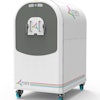Monday, December 1 | 10:40 a.m.-10:50 a.m. | SSC03-02 | Room S404AB
Italian researchers have determined the optimum cutoff of maximum standardized uptake value (SUVmax) for an accurate prognosis of patients with solitary lung nodules.The retrospective, single-center study, led by Dr. Alberto Bazzocchi from the Rizzoli Institute in Bologna, included more than 1,000 patients (mean age, 72.6 years) who underwent PET/CT for solitary lung nodules between January 2002 and May 2012.
The researchers evaluated the patients' clinical history, including images and physician reports of PET/CT exams as well as diagnostic follow-up. Approximately 45% of the patients were diagnosed with non-small cell lung cancer (NSCLC), while the remaining cases (55%) were deemed noncancer or benign tumors.
The area under the receiver operator characteristics (ROC) curve was 0.956, with an SUVmax cutoff value of 2.3. By using that value as the cutoff, the researchers achieved sensitivity of 93% and specificity of 90%.
The study also collected survival data on 459 patients (217 of whom had NSCLC), with a mean follow-up of 70.2 months. Patients who had nodules with an SUVmax greater than 2.3 had an increasingly lower survival rate over one, two, and three years, compared with patients who had an SUVmax less than 2.3
The outcomes were generally the same regardless of lesion size or the type of surgery or nonsurgical treatment.
A cutoff SUVmax of 2.3 is a "very accurate marker for prognosis stratification in patients with solitary lung nodules," Bazzocchi and colleagues concluded.




















